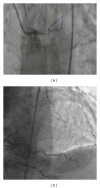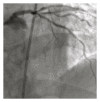Cannabis, collaterals, and coronary occlusion
- PMID: 24987532
- PMCID: PMC4008128
- DOI: 10.1155/2011/469850
Cannabis, collaterals, and coronary occlusion
Abstract
A 51-year-old gentleman, who regularly smoked cannabis, presented with chest pain and diaphoresis. He was haemodynamically stable. ECG showed ST depression, inferiorly, and 1 mm ST elevation in lead aVR. Emergent coronary angiography showed thrombotic occlusion of the left main coronary artery (LMCA), the dominant RCA provided Rentrop grade II collaterals to the LAD. The LMCA was successfully reopened by deployment of a bare-metal stent. Animal heart models suggest that endogenous cannibinoids may cause ischaemic preconditioning. This case suggests that the severity of ischaemia, and hence ECG changes and haemodynamic consequences following an acute occlusion of the LMCA, can be ameliorated by coronary collateralisation and possibly by preconditioning of the myocardium.
Figures
References
-
- Nikus KC, Eskola MJ. Electrocardiogram patterns in acute left main coronary artery occlusion. Journal of Electrocardiology. 2008;41(6):626–629. - PubMed
-
- Yamaji H, Iwasaki K, Kusachi S, et al. Prediction of acute left main coronary artery obstruction by 12-lead electrocardiography. ST segment elevation in lead aVR with less ST segment elevation in lead V(1) Journal of the American College of Cardiology. 2001;38(5):1348–1354. - PubMed
-
- Engelen DJ, Gorgels AP, Cheriex EC, et al. Value of the electrocardiogram in localizing the occlusion site in the left anterior descending coronary artery in acute anterior myocardial infarction. Journal of the American College of Cardiology. 1999;34(2):389–395. - PubMed
-
- Birnbaum Y, Solodky A, Herz I, et al. Implications of inferior ST-segment depression in anterior acute myocardial infarction: electrocardiographic and angiographic correlation. American Heart Journal. 1994;127(6):1467–1473. - PubMed
-
- de Luca G, Suryapranata H, Thomas K, et al. Outcome in patients treated with primary angioplasty for acute myocardial infarction due to left main coronary artery occlusion. American Journal of Cardiology. 2003;91(2):235–238. - PubMed
Publication types
LinkOut - more resources
Full Text Sources




